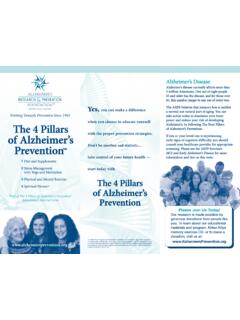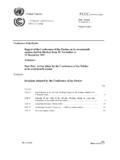Transcription of A Multidomain Two-Year Randomized Controlled Trial to ...
1 This material may be reproduced and shared , provided: a. The ARPF is acknowledged and referenced at b. You tell us about the venue where you shared it. Please email us at 1 A Multidomain Two-Year Randomized Controlled Trial to Prevent Cognitive Impairment- the FINGER study Special Report courtesy of the Alzheimer s Research and Prevention Foundation, which is one of the funding sources for the FINGER study. Background: Observational studies have identified multiple modifiable risk factors associated with increased risk of late-life cognitive impairment and Alzheimer s disease (AD). However, previous smaller and shorter term prevention trials with single-factor interventions have had disappointing or at best modest results.
2 The Finnish Geriatric Intervention Study to Prevent Cognitive Impairment and Disability (FINGER) investigated the effects of a 2-year intervention targeting several lifestyle and vascular risk factors simultaneously. This study is one of the first intervention trials in the world to take a Multidomain approach to dementia prevention. The main aim is to prevent cognitive impairment, and secondary aims include decreasing disability, cardiovascular risk factors and related morbidities, depressive symptoms, and to have beneficial effects on the quality of life. Methods: FINGER is a 2-year multicenter Randomized Controlled Trial with 1260 participants aged 60-77 years recruited from previous studies. Participants were Randomized into either the Multidomain intervention group or the control group.
3 The FINGER multi-domain intervention components are: 1) Dietary guidance 2) Physical activity 3) Cognitive training and social activities 4) Intensive monitoring and management of metabolic and vascular risk factors. The control group received regular health advice. Primary outcome after 2 years is cognitive performance measured by a comprehensive neuropsychological test battery. The 2-year intervention was finalized in February 2014. Results: We found a significant beneficial intervention effect on overall cognitive performance. The beneficial effect was seen on each cognitive domain: memory; executive function, and psychomotor speed. Drop-out rate was only 11%, and participants experiences were very positive. Conclusions: This is the first large RCT showing that it is possible to prevent cognitive decline using a Multidomain intervention among older at-risk individuals.
4 These results highlight the value of the feasible and novel Multidomain approach that is effective for several cognitive domains. This material may be reproduced and shared , provided: a. The ARPF is acknowledged and referenced at b. You tell us about the venue where you shared it. Please email us at 2 ICAD 20091 AlcoholmisuseNeuronal damageBrain reserveAPOE,Other genesDEMENTIAP hysicalactivityRISK FACTORS?0206075 Adult lifeMid-lifeLate-lifeUnhealthydietTransi tionCognitive andsocial activityEducationPROTECTIVE FACTORSS mokingHypertensionDyslipidemiaObesityVas cularinsultsDiabetesAn extended follow-up (7 years) with a sustenance intervention is planned to evaluate longer-term effects on dementia/AD incidence, and secondary and exploratory outcomes including biomarkers and neuroimaging with MRI and PET.
5 Risk Factors Diet intervention The nutritional intervention includes individual counselling sessions (three meetings with the study nutritionist during the first year) and group sessions (seven times during the first year and 1-3 times during the second year). Individual sessions include tailoring of the participant s everyday diet based on the recommendations. Group meetings provide more information and support for facilitating lifestyle changes, and include discussions and practical exercises, such as tools to assess own dietary behaviour (eg. tests to assess fat or fiber intake). The recommended diet is based mainly on the Finnish Nutrition Recommendations. Participants are advised to consume a diet with 10-20% of daily energy (E%) from proteins, 25-35E% from fat (less than 10E% from saturated plus trans fatty acids, 10-20E% from monounsaturated fatty acids, 5-10E% from polyunsaturated fatty acids (including 2,5-3 g/day n-3 fatty acids); 45-55 E% from carbohydrates (less than 10E% refined sugar); 25-35 g/day dietary fiber; less than 5 g/day salt; and less than 5 E% from alcohol.)
6 These goals are achieved by recommending high consumption of fruit and vegetables, whole grain in all cereal products; low-fat options in milk and meat products; sucrose intake less than 50 g/day; using vegetable margarine and rapeseed oil instead of butter, and consumption of fish at least two portions per week. Fish oil supplements are recommended for participants not consuming fatty fish and vitamin D supplementation (10-20 g/day) is advised. Additional dietary measures can be taken according to individual needs related to disease history and medication. This material may be reproduced and shared , provided: a. The ARPF is acknowledged and referenced at b. You tell us about the venue where you shared it. Please email us at 3 The need for weight loss is considered individually and energy intake that facilitates 5-10% of body weight reduction is recommended only if necessary.
7 Additional information on specific foods ( fish) is assessed by a frequency questionnaire Exercise intervention The exercise training program is based on international guidelines and modifying from the Dose Responses to Exercise Training (DR s EXTRA) protocol. The training is guided and supervised by study physiotherapists. The intervention includes individually tailored, progressive muscle strength training and aerobic exercise programs, including exercises to maintain and improve postural balance. Muscle strength training is conducted at the gym and for the first six months is guided by study physiotherapists. Strength training program in standardized to include exercises for the eight main muscle groups (knee extension and flexion, abdomen and back muscles, rotation, upper back and arm muscles, press bench for lower extremity muscles).
8 Postural balance exercises are done within each training session at the gym. Individual aerobic training is planned together with the study participant and comprises activities the study participant prefers and is used to exercising by her/himself. Also aerobic group activities, such as Nordic walking, aqua gym, jogging, and gymnastics are provided within the study. All group activities are guided by study physiotherapists. Muscle strength training and aerobic exercise are recorded in diaries throughout the intervention period. Cardiorespiratory fitness is measured for a sub-group of 400 individuals by a maximal symptom-limited exercise test on a cycle ergometer. Cognitive training and social activity intervention Cognitive training is implemented through group sessions and individual training using a computer-based program modifying protocols previously shown to be effective in RCTs.
9 Training targets episodic memory, executive function, mental speed, and working memory, which are all cognitive measures that show most age-related decline, and are central in everyday situations. The cognitive training consists of 10 group sessions lead by a psychologist (approximately 60-90 minutes/session), when the computer program is introduced, and group discussions on memory-related themes are conducted. Discussions cover topics such as age-related changes in cognition, memory strategies, and every-day memory training. The computer-based training includes two independent training periods of six months each, when participants train using the cognitive training program three times/week, 10-15 minutes/session, for a total of 72 training sessions per period.
10 Computer-based exercises enable an individual-adjusted increase in difficulty levels to facilitate a maximal effect of training. The effect of training is evaluated in testing sessions at the beginning, at three months and at the end of the independent training periods. Social activities are stimulated through the numerous group meetings of all intervention components. This material may be reproduced and shared , provided: a. The ARPF is acknowledged and referenced at b. You tell us about the venue where you shared it. Please email us at 4 Intensive monitoring and management of metabolic and vascular risk factors The metabolic and vascular risk factors of individuals in the intensive intervention group are evaluated by the study physician according to the latest national evidence based guidelines.







